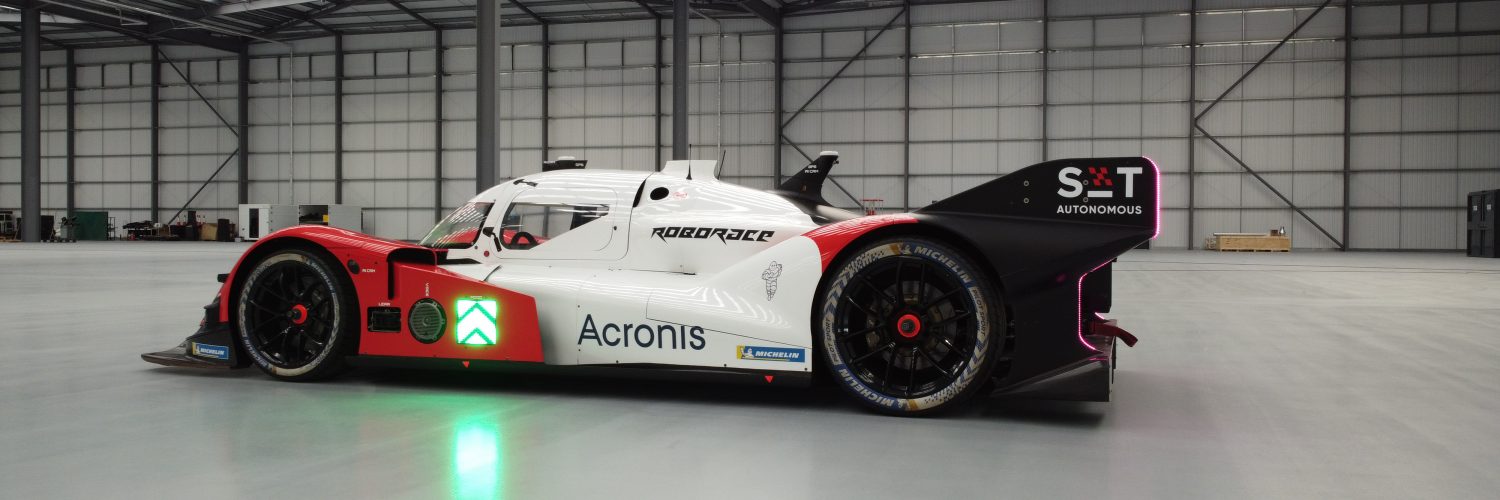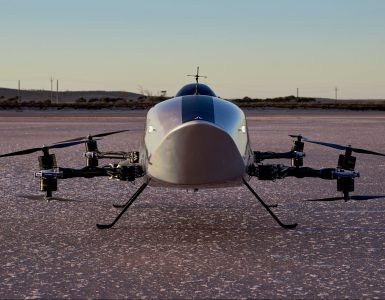Arrival Racing topped the lap times from Acronis SIT Autonomous as the second season of the world’s first autonomous competition of full-size racing robot cars, Roborace, got underway at England’s famous Thruxton race circuit.
After the initial test season, branded ‘Season Alpha’ used locations across Europe and North America to analyse the software and viability of a proper racing season, much was expected as Season Beta 1.1 Round 1 got underway.
London-based Arrival Racing were the first to make their Round 2 attempt, having been the only team to complete three successful laps on an opening day fraught with teething troubles for all of their rivals.
And again the A.I from the lead team seemed to be working well and it augured well for a trouble-free day after the troubles of the day before. But after an encouraging first few corners, the ‘Devbot 2.0’ came to a standstill on the exit of the Thruxton chicane. It meant a first failure for the team that was so impressive on day 1.
But with three laps allowed to set times, the Safety Car brought back the human driver to restart the car and take it back to the start line for its second attempt. Other than the installation lap, it’s the only time a human driver is in the car, before he steps out and lets the Artificial Intelligence software take over.
For all teams, all the A.I programming is therefore done away from the track, from the respective garages and institutes. An average time is taken over the three set laps, Arrival Racing setting the benchmark time of 05.43.11 after a technical glitch meant the signal connection between the car and garage had to be reset as the clock ticked down.
Two second penalties are accrued for hitting the virtual red walled ‘metaverse’ virtual obstacles and going offline to collect bonus orbs leads to a reduction of four seconds off the lap time. The risk-reward balance being is it worth going offline in order to collect them?
Fortunately for Arrival Racing, the issue was deemed a circuit problem and not due to the software, so they were allowed another attempt and the clock paused. And with Arrival Racing having a near faultless three laps, they very much look the team to beat, even at this early stage with 55 collectables and just one obstacle hit to give them an overall time of 04.28.15s.
“Our plan was not to hit the obstacles and collect as many orbs as possible and that seemed to work to plan,” said Alexey Skabelkin, team lead of Arrival Racing.
Next to go were the highly fancied team of SIT Autonomous, backed by Acronis, from the Schaffhausen Institute of Technology, employing a slightly different strategy. After early software teething troubles hampered the team’s opening run on Day 1, it was a much better effort on the second day of running, their Devbot 2.0 enjoying a much better outing in setting an overall time of 04.47.40s, having collected 39 bonus orbs and hitting 6 obstacle walls but going 19 seconds faster than Arrival Racing.
It was a great recovery from the team after Acronis SIT Autonomous was one of the four teams that didn’t complete the Season Beta round 1 race, unexpectedly veering into the barrier after an ‘unexpected software initialization failure’.
“It was an unexpected software initialization failure and our engineers analysed the data and implemented changes to prevent it from happening again,” explained Ilya Shimchik, team lead of SIT Autonomous. “The Acronis SIT Autonomous team successfully recovered, and today won second place in Season Beta round 2, outrunning the MIT and CMU teams. We want to thank our fans and partners for supporting our team and look forward to achieving great results on the track.
“We are happy with that performance and we hoped for the same or an even better result yesterday, but the accident happened yesterday and we learned a lot so we had the improvement and we can say that today was our first round and that’s why I can say the performance for this round was more than we were supposed to have.
Now you are talking @Acronis SIT Autonomous. Congrats! pic.twitter.com/Xs88zop01b
— Roborace (@roborace) October 30, 2020
The Acronis team decided to employ a human element in a safety driver to ensure that there were no problems on the installation lap, and from that point on, the car was flying, making the team a serious contender for the rounds ahead.
“We had some fixes after yesterday and we would like to check some fixes and that’s why we had the first lap with the driver with low speed limits and after we knew everything was fine and working properly we started our racing.
“We had, I would say, ‘hybrid tactics’, so probably it’s pace for us but maybe we can increase the speed or increase the limits for acceleration during the round, but for us it was a tactic to try to go as fast as possible but collecting most of the collectables. For the next rounds we need to pay more attention to the collectables, and we know how to improve it.”
Wall. Again. Virtual this time 🤓 pic.twitter.com/OyAV7MM1xP
— Roborace (@roborace) October 30, 2020
There were still four teams to go, and with Arrival Racing being the only team to set competitive times on Wednesday, it was still all up for grabs for the remaining places after the opening round. And it was…. (TBC)
There were still four teams to go, and with Arrival Racing being the only team to set competitive times on Wednesday, it was still all up for grabs for the remaining places after the opening round. And it was eventually Thursday’s impressive Carnegie-Mellon University who finished third in the standings, pipping MIT driverless, Autonomous Racing Graz and Team Pisa.
TEETHING TROUBLES HIT TEAMS ON DAY 1
It wasn’t just SIT Autonomous that had issues on the opening day in this most technical of new series. There were also technical problems for Autonomous Racing Graz from the University in Styrian region in Austria on the opening day of competition, well known for the Red Bull Ring and also for Nikola Tesla, who enrolled in the Austrian Polytechnic in Graz.
It was a cautious start, the Devbot collecting obstacles and walls in equal measure. And then, with rain starting to fall heavily on the circuit, the Devbot came to a standstill on lap 2 as the rain began to lash down. A slow time, but a time, nonetheless.
Like this playful AI 😎 pic.twitter.com/9HFJ2ocU2C
— Roborace (@roborace) October 29, 2020
Team Pisa of Universita di Pisa also chose the tactic of obstacle avoidance algorithms but have been hampered by development delays due to the effect of COVID-19. Data gathering was the name of the game for them, but yet again, in an attempt to avoid a virtual wall, the failsafe kicked in and the car stopped in order to prevent it hitting a real wall.
A third successive software fail meant that Arrival Racing remained the only team to successfully negotiate three laps. Which meant it was just the two American teams remaining, MIT Driverless and Carnegie Mellon University.
It was MIT the next to go, and finally another successful lap although with the tactic of forgetting the metaverse obstacles and taking the traditional racing line.
All seemed to be going well, but on the second lap and going just as quickly, halfway around another stoppage with all four wheels on the grass due to a GPS signal failure and another DNF.
And, with dark descending on a damp circuit, so finally to Carnegie-Mellon University, where the field of A.I was first invented. Any three clean laps would mean a top two finish. And so it transpired, Carnegie-Mellon managing a clean run despite collecting a bunch of penalties with 53 obstacles and 19 collectables.
It meant second place with a total time of 08.04.41, yet without the obstacles hit, they would certainly have been close behind their London rivals.
“Obviously the first step is getting around the track,” reflected Jimmy Herman, team coach of Carnegie-Mellon University. “Obviously we were kind of pulling back a bit knowing the other teams aren’t making it around the track successfully, weather being an issue and being a little bit more conservative. Obviously we didn’t do well on some of the obstacle avoidance, but we did get around the track successfully, so we’re very happy about that.
“Certainly when you’re using software things can break very easily, so it happened to go right for us today and certainly probably a lot of variants with that.”




